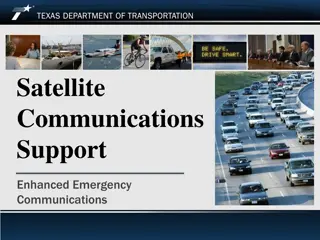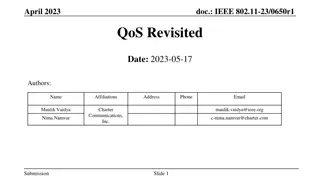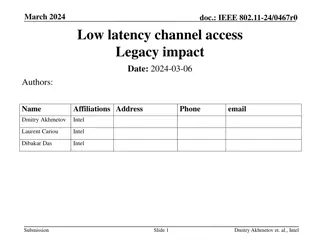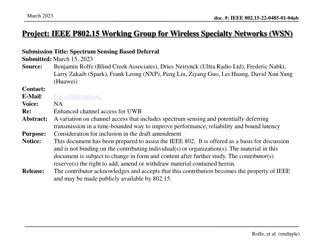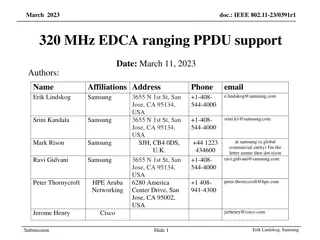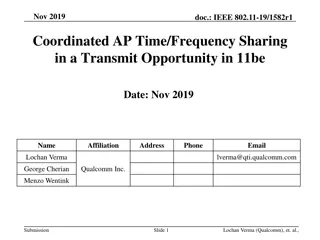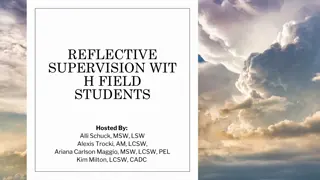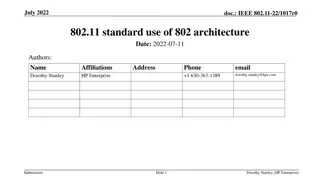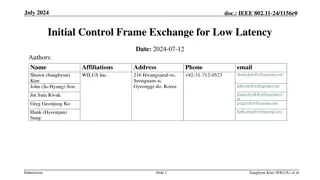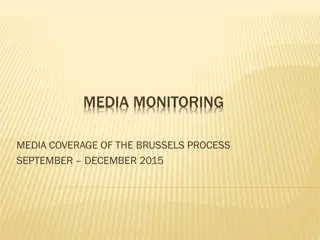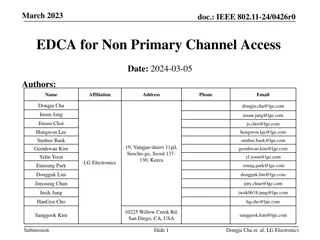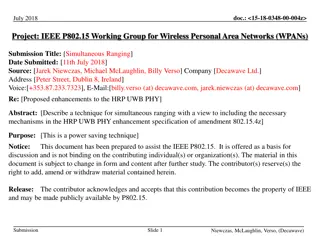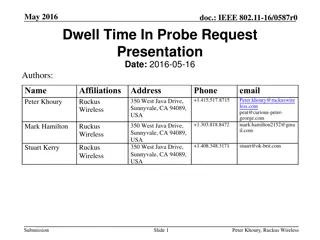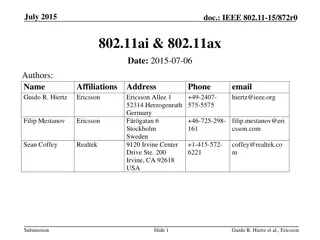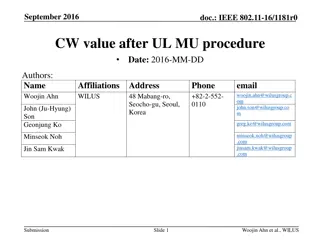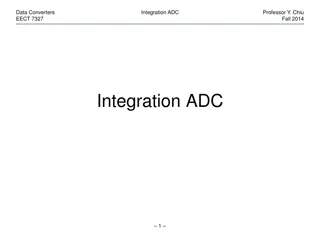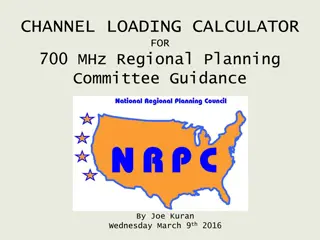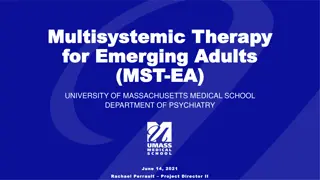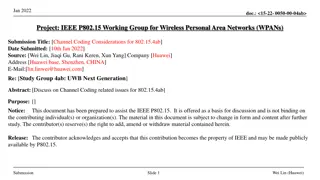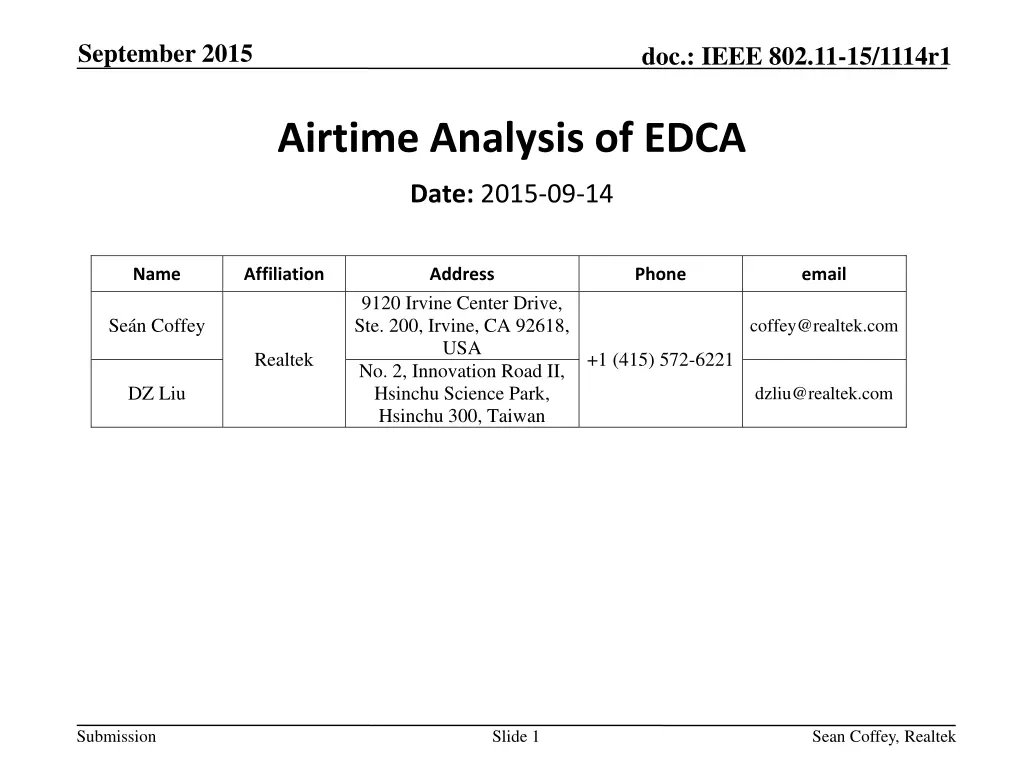
Airtime Analysis of IEEE 802.11-15/1114r1 EDCA in September 2015
Explore the airtime analysis of EDCA medium access overhead in IEEE 802.11-15/1114r1 during September 2015, focusing on components, relationships, and potential enhancements to reduce overhead significantly.
Download Presentation

Please find below an Image/Link to download the presentation.
The content on the website is provided AS IS for your information and personal use only. It may not be sold, licensed, or shared on other websites without obtaining consent from the author. If you encounter any issues during the download, it is possible that the publisher has removed the file from their server.
You are allowed to download the files provided on this website for personal or commercial use, subject to the condition that they are used lawfully. All files are the property of their respective owners.
The content on the website is provided AS IS for your information and personal use only. It may not be sold, licensed, or shared on other websites without obtaining consent from the author.
E N D
Presentation Transcript
September 2015 doc.: IEEE 802.11-15/1114r1 Airtime Analysis of EDCA Date: 2015-09-14 Name Affiliation Address Phone email 9120 Irvine Center Drive, Ste. 200, Irvine, CA 92618, USA No. 2, Innovation Road II, Hsinchu Science Park, Hsinchu 300, Taiwan Se n Coffey coffey@realtek.com Realtek +1 (415) 572-6221 DZ Liu dzliu@realtek.com Submission Slide 1 Sean Coffey, Realtek
September 2015 doc.: IEEE 802.11-15/1114r1 Abstract This presentation examines (some aspects of) EDCA medium access overhead, including the contributions of the different components of overhead and the relationships between them. The analysis is motivated by a separate proposal [6] of an enhanced EDCA-based mode that greatly reduces medium access overhead. Submission Slide 2 Sean Coffey, Realtek
September 2015 doc.: IEEE 802.11-15/1114r1 Cf. Box 3 calibration; all uplink AIFS Backoff CCA High +IFS RTS SIFS CTS SIFS A-MPDU SIFS BA 43 22 20 15 52 16 44 16 356 16 68 668 STAs (here and throughout) include all those competing for the medium; not simply one BSS Submission Slide 3 Sean Coffey, Realtek
September 2015 doc.: IEEE 802.11-15/1114r1 Key I Backoff (backoff counter decrements) averaged per STA and per any successful transmission CCA High (busy medium due to collision) averaged per any successful transmission +IFS (medium idle time in which the STA s backoff counter does not decrement, and is not in the first AIFS) averaged per STA and per any successful transmission Submission Slide 4 Sean Coffey, Realtek
September 2015 doc.: IEEE 802.11-15/1114r1 Key II Successful Tx by any STA; collisions of other STAs 726 0 Submission Slide 5 Sean Coffey, Realtek
September 2015 doc.: IEEE 802.11-15/1114r1 . . . Backoff CCA High +IFS . . . 22 133 15 AIFS Backoff CCA High +IFS RTS SIFS CTS SIFS A-MPDU SIFS BA 43 23 20 15 52 16 44 16 356 16 68 No hidden nodes; measurements taken over interval [5s, 10s] Submission Slide 6 Sean Coffey, Realtek
September 2015 doc.: IEEE 802.11-15/1114r1 Motivation Baseline EDCA medium access overhead = the lower of the two quantities shown The main goal of this presentation is to show that both quantities are usually significant It is possible to achieve much lower medium access overhead than either of these, by re-using well-proven components that are already part of the protocol [6] Submission Slide 7 Sean Coffey, Realtek
September 2015 doc.: IEEE 802.11-15/1114r1 Relationships between components BackoffRTS = BackoffNORTS (1) +IFS RTS = +IFS NORTS (2) CCA High RTS T RTS = CCA High NO RTS T AMPDU (3) +IFS CCA High AIFS (4) T T RTS CCA High RTS (TRTS + TCTS + 2 aSIFSTime) Threshold TAMPDU = TRTS + (5) Submission Slide 8 Sean Coffey, Realtek
September 2015 doc.: IEEE 802.11-15/1114r1 Microseconds Subtract 40 s for 24 Mbps Control Rate (RTS 28 s vs. 52; CTS 28 s v. 44) Submission Slide 9 Sean Coffey, Realtek
September 2015 doc.: IEEE 802.11-15/1114r1 Ratio = ratio to optimum RTS threshold Submission Slide 10 Sean Coffey, Realtek
September 2015 doc.: IEEE 802.11-15/1114r1 Subtract 40 s for 24 Mbps Control Rate (RTS 28 s vs. 52; CTS 28 s v. 44) Submission Slide 11 Sean Coffey, Realtek
September 2015 doc.: IEEE 802.11-15/1114r1 Ratio = ratio to optimum RTS threshold Submission Slide 12 Sean Coffey, Realtek
September 2015 doc.: IEEE 802.11-15/1114r1 Conclusions There is appreciable medium access overhead even at low numbers of contending STAs, with and without RTS 225 s for low contending numbers in BE traffic with RTS, extending to beyond 300 s for high numbers of contending STAs Baseline of 200 s: 43 s AIFS + 22 s Backoff + 128 s RTS-CTS = 193 s, even before considering CCA High and extra IFS 200 s for 12 competing STAs in BE traffic without RTS (for 400 s A- MPDU roughly proportional to A-MPDU size) Significant fraction of A-MPDU airtime when that is below optimum RTS threshold duration Though not simulated here, overhead not much less for VO or VI traffic 9 s lower AIFS; backoff and +IFS slightly lower but low for BE anyway Submission Slide 13 Sean Coffey, Realtek
September 2015 doc.: IEEE 802.11-15/1114r1 References [1] IEEE doc. 11/15-0341r2, Empirical Measurements of Channel Degradation Under Load , C. Lukaszewski, L. Li (Aruba Networks), March 2015 [2] Designing Very High Density Best Practices and Test Results , C. Lukaszewski (Aruba Networks), Wireless LAN Professionals Conference (WLPC) Dallas 2015 [3] G. Bianchi, Performance analysis of the IEEE 802.11 distributed coordination function , IEEE Journal on Selected Areas in Communications, vol. 18 no. 3, March 2000, pp. 535-547 [4] M.X. Gong, E. Perahia, R. Stacey, R. Want, S. Mao, A CSMA/CA MAC Protocol for Multi-User MIMO Wireless LANs , Proc. IEEE GLOBECOM, Dec. 2010, pp. 1-6 [5] IEEE doc. 11/15-0059r1, Uplink RTS/CTS Control , S. Schelstraete (Quantenna), et al., January 2015 [6] IEEE doc. 11/15-1115r1, High Efficiency in Accessing the Medium , S. Coffey, D.Z. Liu (Realtek), September 2015 Submission Slide 14 Sean Coffey, Realtek
September 2015 doc.: IEEE 802.11-15/1114r1 APPENDIX Submission Slide 15 Sean Coffey, Realtek
September 2015 doc.: IEEE 802.11-15/1114r1 (I) RTS on, 1-20 STAs STAs AIFS BO CCA H +IFS RTS SIFS CTS SIFS Thr. s s s s s s s s s 1 43 67 0 0 52 16 44 16 2 43 43 3 1 52 16 44 16 2271 3 43 35 6 3 52 16 44 16 1161 4 43 32 7 4 52 16 44 16 1003 5 43 30 9 6 52 16 44 16 792 6 43 27 10 7 52 16 44 16 699 7 43 26 11 7 52 16 44 16 645 8 43 26 12 8 52 16 44 16 619 9 43 25 13 9 52 16 44 16 551 10 43 25 15 10 52 16 44 16 539 11 43 24 15 10 52 16 44 16 501 12 43 24 15 11 52 16 44 16 477 13 43 23 16 11 52 16 44 16 466 14 43 24 17 12 52 16 44 16 457 15 43 24 17 13 52 16 44 16 453 16 43 23 18 13 52 16 44 16 437 17 43 23 19 14 52 16 44 16 423 18 43 23 19 14 52 16 44 16 407 19 43 23 19 14 52 16 44 16 401 20 43 23 20 15 52 16 44 16 400 Submission Slide 16 Sean Coffey, Realtek
September 2015 doc.: IEEE 802.11-15/1114r1 (II) RTS off, 1-20 STAs STAs AIFS BO CCA H +IFS Thr. s s s s s 1 43 67 0 1 2 43 42 23 2 2271 3 43 35 43 3 1161 4 43 31 55 4 1003 5 43 28 69 5 792 6 43 28 79 6 699 7 43 27 85 7 645 8 43 26 96 8 619 9 43 26 104 9 551 10 43 25 108 10 539 11 43 25 115 11 501 12 43 25 121 12 477 13 43 25 127 13 466 14 43 24 134 14 457 15 43 23 134 15 453 16 43 23 134 16 437 17 43 23 136 17 423 18 43 23 148 18 407 19 43 22 148 19 401 20 43 23 154 20 400 Submission Slide 17 Sean Coffey, Realtek
September 2015 doc.: IEEE 802.11-15/1114r1 (III) RTS on, 10-200 STAs STAs AIFS BO CCA H +IFS RTS SIFS CTS SIFS Thr. s s s s s s s s s 1 43 25 15 10 52 16 44 16 2 43 23 20 15 52 16 44 16 2271 3 43 21 24 18 52 16 44 16 1161 4 43 21 27 21 52 16 44 16 1003 5 43 21 30 23 52 16 44 16 792 6 43 21 32 25 52 16 44 16 699 7 43 21 35 28 52 16 44 16 645 8 43 21 37 29 52 16 44 16 619 9 43 21 40 31 52 16 44 16 551 10 43 21 42 34 52 16 44 16 539 11 43 22 43 34 52 16 44 16 501 12 43 21 45 36 52 16 44 16 477 13 43 21 47 37 52 16 44 16 466 14 43 21 49 39 52 16 44 16 457 15 43 21 51 40 52 16 44 16 453 16 43 22 53 42 52 16 44 16 437 17 43 22 55 44 52 16 44 16 423 18 43 22 57 46 52 16 44 16 407 19 43 22 59 47 52 16 44 16 401 20 43 21 63 49 52 16 44 16 400 Submission Slide 18 Sean Coffey, Realtek
September 2015 doc.: IEEE 802.11-15/1114r1 (IV) RTS off, 10-200 STAs STAs AIFS BO CCA H +IFS Thr. s s s s s 10 43 25 106 10 539 20 43 23 149 15 400 30 43 22 185 19 329 40 43 21 208 21 299 50 43 21 232 24 274 60 43 20 241 25 260 70 43 21 268 28 242 80 43 21 286 29 232 90 43 21 304 31 218 100 43 21 320 33 210 110 43 21 330 34 207 120 43 21 348 36 200 130 43 21 366 38 194 140 43 22 377 39 188 150 43 21 392 41 183 160 43 22 402 42 178 170 43 22 430 45 173 180 43 22 440 46 169 190 43 22 457 48 165 200 43 23 476 50 161 Submission Slide 19 Sean Coffey, Realtek
September 2015 doc.: IEEE 802.11-15/1114r1 (V) Comments on RTS on v. RTS off For fixed number of competing devices, there is an optimum threshold duration for use of RTS/CTS that maximizes throughput Base standard permits defining an RTS Threshold length in bytes Adding threshold duration was considered in 2007 (LB 97) but rejected RTS Threshold length is dynamically settable per STA so capability is equivalent (even if more clumsy than it needs to be) Cf. 11ax SFD item enabling AP to distribute threshold length / duration [5] Optimum threshold duration decreases with increasing contention and with increasing control rates Optimum threshold duration T RTS 1 / CCA High RTS Submission Slide 20 Sean Coffey, Realtek

